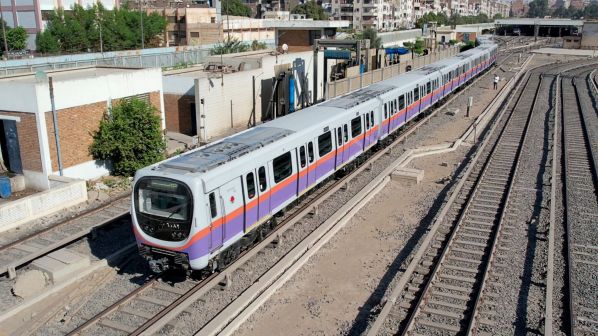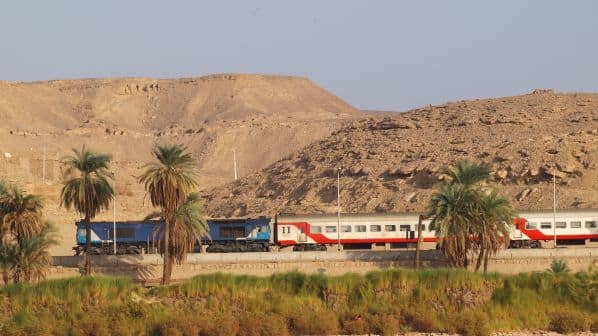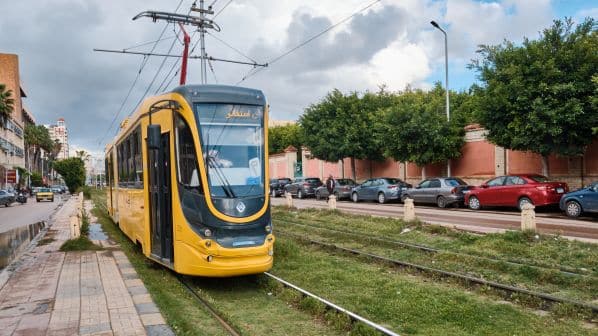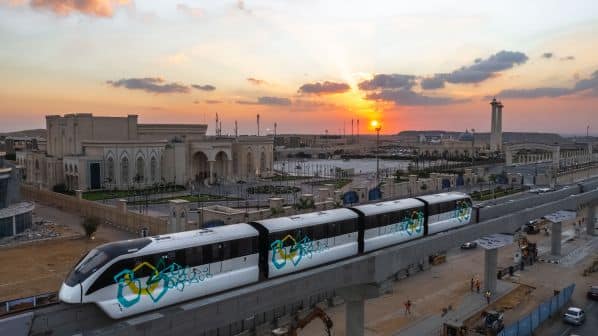High Speed
IN May 2022, the National Authority for Tunnels (NAT) signed a contract with the consortium of Siemens Mobility, Orascom Construction and The Arab Contractors for the design, construction, commissioning, and maintenance for 15 years of three 250km/h lines totalling 1985km. Siemens Mobility’s share of the contract is €8.1bn and includes the initial agreement of €2.7bn for the construction of the first 660km line in northern Egypt, signed in September 2021.
Three types of train will operate on each line, comprising 230km/h express and 160km/h regional passenger trains plus 120km/h freight trains. The three lines will form a network stretching from the Mediterranean to the Red Sea and Sudan border. DB International Operations and Egyptian consultants Elsewedy Electric will be responsible for the operation of the network.
The first line will run from Ain Sokhna on the Red Sea to Alexandria and Mersa Matruh on the Mediterranean, with 20 stations. The project will be carried out in two phases. Phase 1 will be 460km long and connect El Alamein, Alexandria and Ain Sokhna via the New Administrative Capital to the east of Cairo that is under construction. Phase 2 will be 200km long and run from El Alamein west to Mersa Matruh.
In March 2023 Orascom and The Arab Contractors signed a contract with NGE, France, for its subsidiary TSO to build the 330km of double-track line from Ain Sokhna via October 6 City to Borg El Arab. Once completed, the line is forecast to carry 30 million passengers per year, cutting travel times by 50%. Siemens will also supply the rolling stock.
The 1100km second line will run from the greater Cairo area via Qena, Luxor and Aswan to Abu Simbel, near the border with Sudan and will support development along the River Nile. The 225km third line will connect Qena with Hurghada and Safaga on the Red Sea, serving World Heritage archaeological sites.
Metro: Cairo
REHABILITATION of Cairo Metro Line 2 involves the 23km line running from Shoubra-El-Kheima to Cairo University, with an extension to Giza, which opened in 2000. The project includes renewing rolling stock and signalling, updating the power supply, control and electro-mechanical systems, and civil works. The project will increase the line’s overall capacity by around 50%. EBRD is lending €250m,while the European Investment Bank (EIB) has provided €240m and the Egyptian government is covering the remaining cost of the project. The Egyptian Company for Metro (ECM) will operate the line. The Egyptian Ministry of Transport signed a £E 150.8bn ($US 4.9bn) contract with Hyundai Rotem for 48 metro trains for Line 2 in June 2019 following an earlier order placed with the manufacturer to supply 256 metro cars for Cairo Metro Line 3 Phase 3.
An extension of Cairo Line 2 is currently at the preliminary design stage. Initially a 7km section will be built north from Shubra Al-Kheima to Qalyub, followed by a further 1.8km to a multi-modal interchange at El Mounib. The extension will parallel ENR’s Cairo - Alexandria main line and is expected to cost £E 3bn. NAT has awarded Systra a contract to conduct a detailed design and feasibility study.

Cairo Metro Line 3, when completed, will be 17.7km long with 15 stations. Construction is divided into three phases and the 4km Phase 3A, from Attaba to Kit Kat, opened on October 6 2022. The line is expected to carry 30,000 passengers per hour per direction.
The 6.6km, six-station Phase 3B, from Kit Kat north to Rod al-Farag is under construction. A consortium of Vinci Construction Grand Projets, Bouygues Travaux Publics, Orascom Construction and Arabco Contractors is responsible for civil works. Consultancy services are being provided by a consortium of Systra, Egis Rail, ACE and EHAF, while signalling, telecommunications and electro-mechanical equipment are being supplied by a consortium of Alstom and Thales, Colas Rail, Orascom and Arabco. Project management is being undertaken by Hill International. The 7.1km, five-station Phase 3C from Kit Kat south to Cairo University is also under construction with the same contractors, suppliers and project managers as for Phase 3B.
Phase 4C of Line 3 is still at the planning stage. It will comprise a 6.65km extension and will link Heliopolis with Cairo International Airport via Al-Hegaz Square, the Military Academy area and Sheraton District. The underground line will improve transport in east Cairo. Once all phases are completed, Line 3 will connect the centre of Cairo with the planned New Administrative Capital development of Wedian. Overall consultant for the project is Arab Consulting Engineering Moharram Bakhoum, while design consultant is a consortium of Systra and Arab Consulting Engineering Moharram Bakhoum. Operation and maintenance of Line 3 will be undertaken by RATP Dev.
Cairo Metro Line 4, when completed, will be 42km long and serve 38 stations. The $US 4bn Line 4 Phase 1 project involves the construction of a 19km section linking the Giza Pyramid Complex in the southwest with central Cairo. The line will also provide a connection between Hadayek El Ashgar in 6th October City and Malek El Saleh in New Cairo and will benefit high-density population areas such as El Haram, Faysal, El Omraniya, Giza, Nasr City, Al Azhar University and New Cairo.
Construction of the 13.7km western section of Line 4 Phase 1, from Hadayek El Ashgar to Amr Ibn Al-Aas, started in January 2023 with construction being undertaken by Arab Contractors with Petrojet, Concord and Hassan Allam Construction. The section will have 12 stations and will carry around 2 million passengers per day. The government of Egypt and the Japanese International Corporation Agency (Jica) signed a loan agreement of Yen 41bn ($US 306.9m) for Phase 1 on December 26 2022. Rolling stock will be supplied by Mitsubishi and Kinki Sharyo. Tracklaying and depot construction, as well as the installation of rail systems, will be undertaken by Colas Rail, Orascom Construction and Thales.
The planned 23km Line 4 Phase 2 will run from Amr Ibn Al-Aas station, reaching the rolling stock depot and workshop area east of the ring road. It is expected to open in 2027.
The planned 20km Line 5 will run in a semi-circle from El Wfaa Wel Amal in Nasr City in the east to Port Said Street and Shubra El Kheima in the west and will have interchanges with all other metro lines in Cairo.
The planned 30km north-south Line 6 will comprise a 20km underground section, then a 10km elevated section from El Khosous southwards to the east of Shubra Al Khiemah, before running parallel with the Ismailia Canal to reach El Sawah Square. It will then follow Port Said Street to cross above Line 1 at Ghamrah, before continuing to El-Sayeda Zeinab Square, El Fustat Park and terminating at New Maadi. The line is forecast to carry 500,000 passengers per day. Alstom secured a $US 4bn contract from Egyptian Company for Metro Management and Operation (ECMMO) to finance and construct the line.
Main Line
IN November 2021, Egyptian National Railways (ENR) signed an agreement with Thales to modernise two of its principal lines located in the Nile Delta region. Work on the Qalyoub - Menouf - Tanta line involves resignalling and track doubling to boost capacity on the 94km route. In parallel, Thales will explore both the possibility of installing ETCS Level 1 on the line and implementing a national traffic management system. The other project involves resignalling, including installation of ETCS Level 1, track upgrades and doubling of the 64km Qalyoub - Shebin El Qanater - El Zagazig line.
The 80km Aswan - Wadi Halfa line project is at the preliminary design stage and follows an April 2021 initiative whereby the governments of Egypt and Sudan agreed to connect their railway networks. The line will be used both by freight and passenger trains, with Egypt keen to use it to export goods to Sudan, and further south.
In November 2020, the two governments signed a cooperation agreement to carry out economic, social and environmental feasibility studies. They specified that the line would be built to Egyptian specifications.

Modernisation of the 224km Luxor - Aswan High Dam line, involving new control systems and the installation of electronic signalling and automatic barriers at 70 level crossings, is intended to improve safety and reduce headways to increase passenger and freight capacity as well as raising the maximum line speed from 120km/h to 160km/h. The line serves major tourist attractions, including the Luxor Temple and the Valley of Kings, and moves agricultural products from near the River Nile. Korea’s Exim Bank will finance the project through an Economic Development Cooperation Fund (EDCF) and the Economic Development Promotion Facility (EPDF).
A feasibility study is being carried out into potential modernisation of the 119km Tanta - El Mansoura - Damietta line, including track doubling of the 65km El Mansoura - Damietta section and resignalling of the entire line, improvements to communication systems, station upgrades, and a new freight yard with a rail connection to Damietta port. The project will improve safety, availability and reliability of a vital rail corridor through the Nile Delta.
The cost of the project is estimated at €581m. In May 2022 the Egyptian cabinet approved a draft agreement under which the European Investment Bank (EIB) will provide a €221m loan for the project.
The 69km 10th of Ramadan Railway Link will connect the 10th of Ramadan Dry Port (DP10) PPP project to ENR’s main network and allow freight traffic to and from several ports to bypass the Cairo area. The line will carry container trains, commuter services between Robeiky, 10th of Ramadan, and Belbeis, and will contribute to modal shift of freight and passenger traffic from road to rail. The DP10 dry port is located east of Cairo and west of Suez. The Robeiky - 10th of Ramadan - Belbeis freight line will be linked to the Cairo - Suez and Cairo - Zagazig lines via an industrial park at East Cairo. Funding is being provided by lenders including the European Bank for Reconstruction and Development (ERBD), which has provided €40m. The remaining cost will be financed by another financial institution via a sovereign loan and the government of Egypt will self-fund the civil works.
Commuter rail
PHASE 4 of the El-Salam - New Administrative Capital - 10th of Ramadan commuter rail project, known locally as Light Rail Transit, will extend the recently completed phases 1 to 3 of the 103.3km line, which opened in July 2022, by 16km north from Knowledge City. Of the 16km, 7.5km will be elevated and 8.5km at grade. The line is expected to carry 500,000 passengers per day with an operational speed of 120km/h, interchanging with the Cairo metro at Adly Mansour, the monorail at the City of Arts and Culture station in the New Administrative Capital, and with mainline trains at the central station.
The Export and Import Bank of China (China Exim Bank) has provided financing for the project with construction underway by a consortium of China’s Avic International and China Railway Group, Concord, Hassan Allam Holding and Petrojet. Trains are supplied by CRRC Qingdao Sifang and the operator is RATP Dev Mobility Cairo.
Monorail
TWO monorail lines are due to open in Cairo this year. In May 2019, Egypt’s Ministry of Transport selected an Alstom-led consortium of Egyptian companies Orascom Construction and Arab Contractors to design, build, operate and maintain both lines for 30 years.
The first line is 56.5km long and runs from East Cairo on metro Line 3 east through Nasr City to the New Administrative Capital. The second line is 42km long and runs from the Mohandseen district in Giza west to 6th of October City. When it opens the line will have 13 stations and will have an interchange with the metro Line 3 extension to Cairo University at Wadi El-Nil.
The final cost of the two lines is expected to be $US 4.5bn. Funding is being provided by UK Export Finance (UKEF), which will guarantee 80% of borrowing totalling €2.5bn from JP Morgan, and New Urban Communities Authority (Nuca) through a loan with a repayment period of 14 years.
Metro and light rail: Alexandria
ALEXANDRIA’s first metro line will eventually be 43km long and will run from Abu Qir in the east to Borg al-Arab in the west. The project is divided into three phases. Phase 1 involves the conversion of the 22km railway between Abu Qir and Misr into an electrified metro with 18 stations, and when completed it is forecast to carry 60,000 passengers per hour per direction. NAT commissioned Systra in 2019 to conduct a feasibility study covering both outline and more detailed design. In December 2022, the Asian Infrastructure Investment Bank (AIIB) approved a €250m loan to Egypt for the project. Funding is also being provided by EIB, the French Development Agency (AFD) and EBRD. Phase 2 will be 8km long and will run from Misr to Al-Max in the southwest. Systra is undertaking feasibility studies, outline and detailed design, as it is doing with Phase 3, which will be 15.5km long and run from Al-Max via Alkyl to the Cairo - Alexandria desert road.

The Alexandria Raml tram rehabilitation and extension project involves rehabilitating a 13.8km light rail line in Alexandria with 28 stations and which is used by 12% of the city’s commuters daily.
The project includes constructing footbridges, updating signalling and renewing the rolling stock, as well as extending the line by 900m from Al-Raml Square to Ahmed Orabi Square in Al Manshiya.
The Ministry of Investment and International Cooperation and AFD have signed a €100m loan agreement for the project, which is expected to increase capacity from 100,000 to 300,000 passengers per day. The design, supervision and construction contract has been awarded to a consortium led by Systra with partners Egis, ACE and Projacs.

